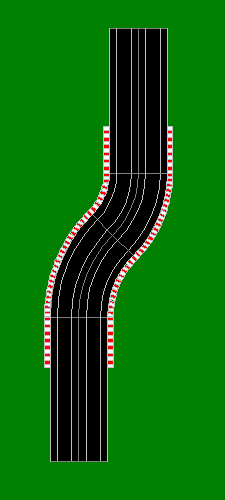Turn Borders
Tribute Site |
|
|

|
|
|

|
|
|
| Turn Exit Easements |
|
A portion of the track following a turn should also have a border. A drifting car requires a few inches following a turn to right itself. If your race track is to be run in both directions then you will want to add borders both before and after a turn so that regardless of the direction of travel an apron will always follow a turn. |

|
|
|

|
|
|
| Materials |
|
Two materials are commonly used to create turn borders; Foam-Core display board and Masonite hardboard. Both of these materials are available in sheet form and can be found in ¼" thicknesses. |

|
|
|
|
|
| Layout Templates |
|
With either material, the easiest way to layout your cutting guides is to place the track directly on top of the board and then trace the outside edge with a regular No. 2 lead pencil. HO scale track borders should be at least ¾" wide. A second cutting line will need to be drawn outside of this first line if the border being made is for an outside turn. Borders for inside turns will require a second cutting line inside the first. |
| Gluing Track Joints |
|
This next step is optional, but will make laying out your turn borders much easier, and also provide for a smoother running race track. HO Slot Car track normally snaps together and is fastened at the joints with small plastic retaining tabs. These tabs can be glued to better keep the sections squarely joined. If you elect to glue track sections together assemble the various turn sections comprising each turn on a flat smooth surface first. |
|
|
|
|
| Soldering Power Rails |
|
This next step is also optional, and should only be attempted if you have glued your track sections together as described above. The weakest link in power delivery on longer HO Slot Car tracks are the joints at each track section. Soldering the power rails at each of these joints will make a better electrical connection and allow power to flow more evenly around the entire racing circuit. See the Soldering page for more information and to purchase the proper tools and supplies for soldering track rails. |
|
The soldering steps described below should be practiced first on scrap track sections. Try soldering the power rails on several scrap sections to get the hang of it before you attempt to solder your actual track. |
| Cutting Out Borders |
|
Once you've traced cutting lines using the actual track as a template or a beam compass, it's time to cut out the borders. |
| Painting The Borders |
|
Foam-Core track borders need to be masked using ½" 3M Masking Tape. Place the tape widthwise at ½" intervals to create striped borders. With the masking tape applied, paint the borders using red enamel spray paint. After the red paint has dried, carefully remove the masking tape to reveal the white sections of the track borders. Your track borders are now ready for installation on your racetrack. |

|
|
|
| Installing The Borders |
|
Your HO Slot Car track borders are now ready for installation on your racetrack. If you glued and soldered your layout's corner sections then arrange these on your table and join them together with the connecting straights. You can repeat the gluing and soldering operations on your track's straight sections as well, but lay the entire track out first. Most HO Slot Car track designs require slight adjustments to make the entire track line up. |
| HO Track Borders |
|
HO Turn Border material is now available! These borders are molded using Black Neoprene Rubber and can easily be wrapped around the outside or inside of any turn radius size. They are exactly the same height as HO track, so they can be used to create a smooth apron. See the Landscaping section for pictures of these borders applied to an actual racetrack. |

|
|
|
|
|
| HO Track Border Sample | $0.75 |
|
| 3 Foot HO Track Border | $6.79 |
|
| 4 Foot HO Track Border | $8.99 |
|
| 5 Foot HO Track Border | $10.99 |
|
| HO Track Border (20 Foot Minimum) | $1.99 |
|
|
Note: When ordering continuous rolls of HO Track border material you must enter a Shopping Cart Quantity of 20 or More feet! |
|
|
| FISA Curb Tape Kit (27 Feet) | $22.99 |
|
 Most hobby
shops sell a product call Plastruct Plastic Weld. This is a
solvent-based product that when applied to two adjoining pieces of
plastic will actually melt, or weld them together. After gluing sections together let them cure overnight for a strong bond.
Most hobby
shops sell a product call Plastruct Plastic Weld. This is a
solvent-based product that when applied to two adjoining pieces of
plastic will actually melt, or weld them together. After gluing sections together let them cure overnight for a strong bond.